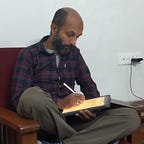The Gun Salute
Do the cross and the gun go together?
No.
Yet at the funeral service of His Grace Dr. Joseph Mar Thoma Metropolitan this contradiction was on display. Just before the part of the service which takes place near the grave began, the Church allowed a group of police men to offer State honours to the deceased Bishop in the form of a gun salute - a standard format that is considered, perhaps, the highest honour a secular state can offer at a funeral.
A church, cannot request the state government for such a gesture. But, a secular state government decided to do so.
The moment was rich in symbolism. The cross, the gun, the grave.
The Kerala state government, it seems, did not to find profound condolences enough. Via Zoom or through representatives, the Prime Minister of the Sovereign, Socialist, Democratic Republic of India, the Kerala State Governor and the Chief Minister offered their respects in touching words. The words were heartfelt and had deep christian undertones. One would even doubt whether they really represented the ideologies each of them had espoused.
The glorious figure of the Late Metropolitan, sat holding, wearing and seemingly leaning on a cross - the symbol of a capital punishment that turned out to be a symbol of love, hope and victory of good over evil.
And then came the police men with the guns.
You would not miss it. The area was cleared. The gun wielding police-men marched in and performed the gun salute.
It was a silent, awkward juxtaposition of two different symbols of power that represented death. So the police-men , designated by the State went ahead and expressed their respect in the only language that the State knows, in the end - the language of the gun.
In the end, that's the highest language of honour that a man-made institution known as the democratic state could express. With all due respect, one couldn't miss the clash of these two symbols at a christian funeral. One stood for self-less love, a love for one's 'neighbour', a love that turns the other cheek. It used to be a symbol of death but was transformed into a testimony of love. The other was a study in contrast. At the end of the day, guns make graves. More guns, more graves. And the power of the state, when all is said and done, will be made known (God-forbid) by the gun. History stands witness.
Interestingly, the guns did not fire. Instead, they stood silent at the grave of the Metropolitan - a human who represented the whole Christian community - a community which believes guns cause death, but proclaiming and practicing the love of the cross, and the hope of resurrection in Jesus Christ leads to eternal life.
Instead of gun blasts, there was the sound of the bugle - the bugle of State honours , near the mortal remains of a man who held and preached the cross ( and the hope of resurrection it offered). The remains would soon turn into dust, like everyone else's. Yet, knowingly or unknowingly, the bugles seemed to sound the victory of a love that was portrayed on the cross - the love of God, through Jesus Christ. And the end of the funeral service, was evocative of that victory. As the service concluded with the benediction, another bishop began one last song, as he stood in front of the grave, surrounded by the faithful, who believed in the cross of Jesus Christ :
Ha halleluiah, jayam halleluiah, Yesu Karthaav jeevikkunnu!
( Halleluiah! Victory! Praise God! Jesus Christ is risen and lives today)
The crowd stood around and sang along as one.
-Mathews George (Rev.), Mar Thoma Syrian Church
